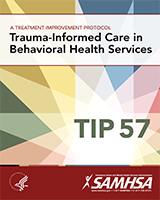Exhibit 2.1-1TIC Planning Guidelines
The following publications provide samples of organizational guidelines for implementing TIC.
Fallot, R. D. & Harris, M. (2009). Creating cultures of trauma-informed care (CCTIC): A self-assessment and planning protocol. Washington, DC: Community Connections, 2009.
Guarino, K., Soares, P., Konnath, K., Clervil, R., & Bassuk, E. (2009). Trauma-informed organizational toolkit. Rockville, MD: Center for Mental Health Services, Substance Abuse and Mental Health Services Administration; the Daniels Fund; the National Child Traumatic Stress Network; and the W. K. Kellogg Foundation.
Huckshorn, K. (2009). Transforming cultures of care toward recovery oriented services: Guidelines toward creating a trauma informed system of care. In
Trauma informed care (TIC) planning guidelines for use in developing an organizational action plan. Alexandria, VA: National Association of State Mental Health Program Directors.
Ohio Legal Rights Service (2007). Trauma-informed treatment in behavioral health settings. Columbus, OH: Ohio Legal Rights Service.
Prescott, L., Soares, P., Konnath, K., & Bassuk, E. (2008).
A long journey home: A guide for creating trauma-informed services for mothers and children experiencing homelessness [draft]. Rockville, MD: Center for Mental Health Services, Substance Abuse and Mental Health Services Administration; the Daniels Fund; the National Child Traumatic Stress Network; and the W.K. Kellogg Foundation.
The following resource is a system wide set of guidelines for implementing TIC.
U.S. Department of Health and Human Services, Health Resources and Services Administration (2006). Model trauma system: Planning and evaluation. Rockville, MD: Health Resources and Services Administration.
